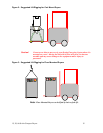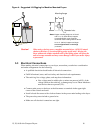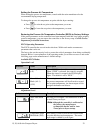
3-4 Setup Procedures
This section provides the procedures necessary for configuring your Dehumidifying Dryer.
Configuration of your dryer includes checking for proper blower rotation, making
dryer/drying hopper process air connections and the optional aftercooler (on 15 and 30 cfm
models). We recommend that you carry out these procedures in the order given here.
Note: Before carrying out these procedures, install all equipment as
described in this section.
Checking for Proper Blower Rotation
Three-Phase Models
Caution! In three-phase models, incorrect phasing of power leads can cause
backward rotation of blower motors and CONTAMINATION OF THE
DESICCANT!
Always check blower rotation before putting material in the drying hopper!
The blower is rotating properly when air flows from the delivery outlet.
Note: Holding your hand in front of the air return will also indicate if the
blower rotates in the proper direction.
If the three-phase blower rotates improperly, reverse any two wires at the fused disconnect
outside the dryer or at the disconnect/terminal in the control enclosure. This assures that the
blower rotates in the proper direction.
Making Dryer/Drying Hopper Process Air Connections
Floor Mount Models
When making process air connections to your floor mounted dryer, ensure that you take into
consideration and make arrangements for the following:
• Use high-temperature flexible dryer hose or rigid tubing to connect the dryer to the
drying hopper.
• Keep the delivery hose to the drying hopper as short as possible to minimize heat loss.
We strongly recommend insulated hose for maximum energy savings.
• Do not use insulated hose on the return from the drying hopper.
• The return air to the blower must be 150°F (66ºC) or below. If the return air
temperature is not below this point, you should purchase and install the optional
aftercooler to remove excessive heat. Consult the manufacturer for more information.
Aftercooler considerations also apply to machine-mount models.
• Make sure that hoses are not kinked or collapsed.
• Drying hopper air inlet and outlet locations vary, but always connect hoses so the dry
process air from the dryer enters the bottom of the drying hopper and flows out the top
to return to the dryer inlet.
• Thermocouple is to be installed at drying hopper’s delivery tube.
15, 30, & 60 cfm Compact Dryers 17


















